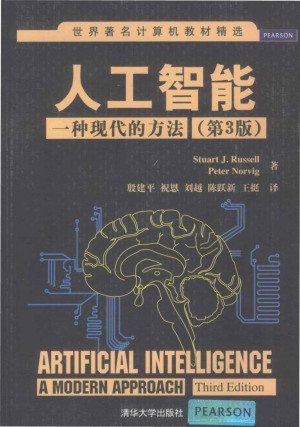
书: https://pan.baidu.com/s/1A6ZLSPMbCiZ-L4eRucUvXQ?pwd=kt7i
一些笔记分享给大家:
一、基础定义
- “AI is the study of agents that receive percepts from the environment and perform actions.”
(AI研究能感知环境并执行行动的智能体。) - “Rationality is doing the right thing, given what one knows; perfection is unattainable.”
(理性是在已知条件下做正确的事,完美不可企及。)
二、搜索与规划
- “A search is optimal if the heuristic is admissible (never overestimates the true cost).”*
(若启发函数可容(永不高估真实代价),A*搜索最优。) - “Constraint satisfaction problems (CSPs) exploit domain-specific heuristics to reduce search space.”
(约束满足问题利用领域启发式缩小搜索空间。)
三、知识表示
- “First-order logic is expressive enough to represent ‘there exists an x such that…’, unlike propositional logic.”
(一阶逻辑可表达“存在某个x使得…”,命题逻辑则不能。) - “The frame problem: how to succinctly specify what does not change when an action is performed.”
(框架问题:如何简洁描述动作执行后未变化的部分。)
四、不确定性推理
- “Bayesian networks compactly represent joint distributions via conditional independence.”
(贝叶斯网络通过条件独立性压缩表示联合分布。) - “Markov decision processes (MDPs) formalize sequential decision-making under uncertainty.”
(马尔可夫决策过程形式化不确定性下的序列决策。)
五、机器学习
- “Overfitting occurs when a model fits noise in the training data rather than the underlying pattern.”
(过拟合是模型拟合训练数据噪声而非真实规律。) - “The bias-variance tradeoff: simple models have high bias, complex models have high variance.”
(偏差-方差权衡:简单模型偏差高,复杂模型方差高。)
六、神经网络
- “Backpropagation is just gradient descent with the chain rule applied to compute gradients.”
(反向传播是链式法则下的梯度下降。)
七、伦理与哲学
- “The Turing Test is about deception, not intelligence—a philosophical limitation.”
(图灵测试关乎“欺骗”而非智能,存在哲学局限。) - “Asimov’s laws of robotics fail in edge cases due to ambiguity in ‘human’ and ‘harm’.”
(阿西莫夫机器人三定律在边缘场景中因“人类”“伤害”的模糊性失效。)
八、强化学习
- “Exploration vs. exploitation: the agent must balance trying new actions and maximizing rewards.”
(探索与利用:智能体需平衡尝试新动作与最大化奖励。)
九、自然语言处理
- “The ambiguity of language requires world knowledge to resolve, not just statistical patterns.”
(语言歧义需世界知识而不仅是统计模式来解决。)
十、AI未来
- “General AI requires integration of perception, reasoning, learning, and action—no component suffices alone.”
(通用AI需整合感知、推理、学习与行动,单一组件不足。)
附:经典问题表述
- “The Chinese Room argument: syntax manipulation does not imply understanding.”
(中文房间论证:语法操作不等于理解。) - “Moravec’s paradox: easy tasks for humans (vision, movement) are hard for AI, and vice versa.”
(莫拉维克悖论:人类轻松的任务(视觉、运动)对AI极难,反之亦然。) - “The symbol grounding problem: how symbols acquire meaning without human interpretation.”
(符号接地问题:符号如何不依赖人类解释获得意义。) - “AI’s impact will be limited not by its capabilities, but by our ability to specify goals correctly.”
(AI的局限将源于人类定义目标的能力,而非技术本身。)